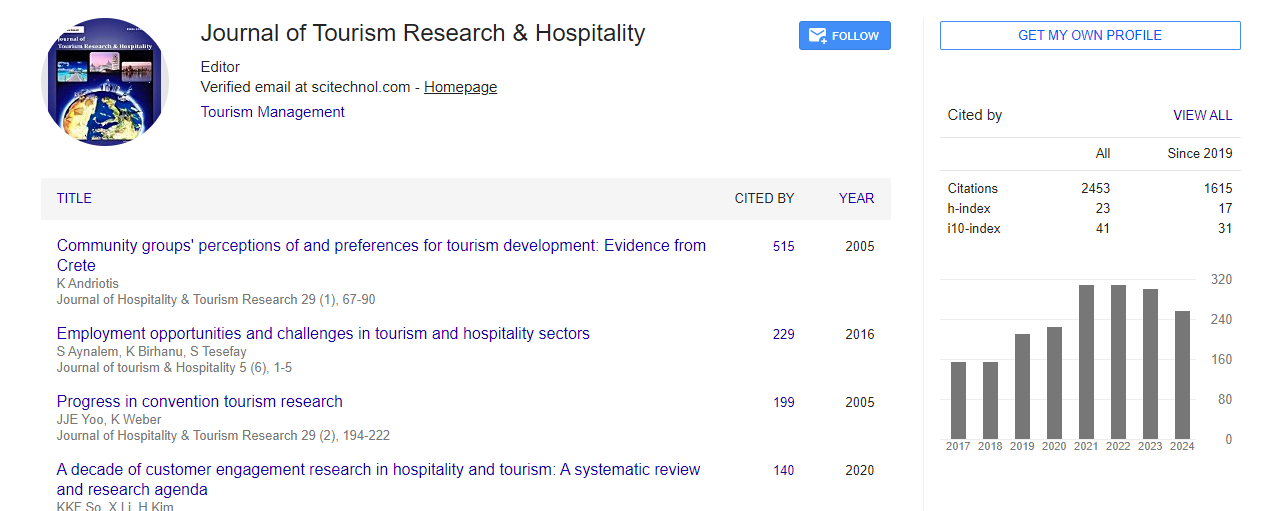Commentary, J Tourism Res Hospitalit Vol: 11 Issue: 2
A Mutual Threat Problem for Tourism Restrictions in the Context of COVID-19
Chris Ryan*
Department of Hotel and Tourism Management, the Hong Kong Polytechnic University, Tai Po, Hong Kong, China
*Corresponding Author:
Chris Ryan
Department of Hotel and Tourism Management, the Hong Kong Polytechnic University, Tai Po, Hong Kong, China
E-mail:chrisryan@gmail.com
Received date: 03 February, 2022, Manuscript No. JTRH-22-48301;
Editor assigned date: 09 February, 2022, Pre QC No. JTRH-22-48301 (PQ);
Reviewed date: 17 February, 2022, QC No JTRH-22-48301;
Revised date: 21 February, 2022, Manuscript No. JTRH-22-48301 (R);
Published date: 24 February, 2022, DOI:10.4172/jtrh.1000222
Citation: Ryan C (2022) A Mutual Threat Problem for Tourism Restrictions in the Context of COVID-19. J Tourism Res Hospitalit 11:2.
Keywords: COVID-19, tourist restrictions
Introduction
The coronavirus disease pandemic of 2019 (COVID-19) is one of the most shocking global crises in recent history. COVID-19 has affected over 100 million people and killed over 2 million people worldwide according to data from Wuhan, China [1]. The consequences of the COVID-19 pandemic are not limited to public health. Mobility restrictions and a halt in the economy have resulted in historical declines in every nation on the planet. In the EU, GDP is expected to fall by nearly 8% in 2020, and most tourism-dependent countries are expected to see a dramatic drop in GDP (e.g., 12% in Spain, 10% in Italy, and 9% in Greece, to name three of the most affected) [2].
Pandemic
The 1918 Spanish Flu pandemic had a similar precedent to this COVID-19 pandemic, but the world was not as connected back then as it is now [3]. Since then, the travel and tourism industry has grown from a minor niche to one of the world's major industries. Despite the fact that tourism accounts for approximately 10% of global GDP, its contribution by country and region is far from uniform. Only in Europe do you find such a wide range of variation [4]. In some countries (e.g., Poland) tourism accounts for less than 5% of GDP, whereas in others, such as Croatia, tourism contributes more than 25% of GDP. Worldwide, the disparities are even more pronounced, with several countries accounting for more than half of their GDP through tourism.
Many studies have recently been conducted to determine the best policies and non-pharmaceutical interventions to contain the pandemic while minimizing economic damage [5]. Common conclusions are that the effectiveness of interventions is dependent on the local context, such as timing, that they should be used with caution in policy decisions, and that they must be focused on specific points of interest [6]. Because of this plethora of policies, the majority of tourism destinations has implemented travel restrictions and has gone through various stages during the COVID-19 pandemic, ranging from being able to accept tourists to having a complete lock down and not being able to accept a single visitor. As a result, finding the best conditions for the tourism sector in this COVID-19 context has gained prominence in the industry [7].
Epidemiological Situation
Furthermore, researchers discovered that another important factor in controlling the COVID-19 pandemic is the role of coordination among regions and countries for the best performance of the proposed policies [8]. To maintain the pre COVID-19 operational levels of the tourism and travel sector, private and public organizations must work together. Tourism is an ecosystem that must bring together many actors from various geographical locations, and the tourist must be confident in the safety of her/his trip (i.e., a low perceived risk). As a result, coordination of restrictions and reopening between origin and destination tourism regions is now required to control the epidemic and reduce economic costs [9].
Main objective here is to examine the conditions for achieving coordination among groups of regions or countries (we will use the term "regions" from now on), taking into account both economic costs and the risk of a global lock-down due to a severe epidemiological situation [10]. Some regions will impose restrictions on mobility and leisure activities in order to avoid the risk of extreme infection rates, which could lead to a global economic collapse. However, these restrictions would result in economic losses for those regions. As a result, regions may be tempted not to cooperate in order to benefit from the stable public health conditions achieved as a result of restrictions imposed by other regions.
References
- Foram K, Anubbhav M, Pritish M (2013) Display message on notice board using GSM. Adv Electr Elect Eng 3: 827-832.
[Crossref], [Google Scholar]
- Jagan Mohan R, G Venkareshwarlu (2013) Wireless electronic display board using GSM technology. Int J Electr Electr Data Commun 1: 50-54.
[Crossref], [Google Scholar]
- Anuradha M, Vaishali N, Deepika S (2014) Scrolling LED display using wireless transmission. Int J Eng Dev Res 2: 475-478.
[Crossref], [Google Scholar]
- Savan Shah (2015) Message displayed on LCD screen using gsm and bluetooth technology. Int J Adv Res Comp Commun Eng 4: 345-347.
[Crossref], [Google Scholar], [Indexed]
- Darshika M, Mamta T, Rageeni W, Vivek G (2018) Review on electronic notice board. Int Res J Eng Technol (IRJET) 5: 592-594.
[Crossref], [Google Scholar]
- Rachel Sugar (2016) More tourists visited NYC in 2016 than ever before. Vox Media.
[Crossref], [Google Scholar], [Indexed]
- Dheeraj V (2020) Smart notice board using NodeMCU ESP8266. Int Res J Eng Technol (IRJET) 7.
[Crossref], [Google Scholar]
- 7. Asmita K, Mugdha R, Vikas G, Pranjal S (2020) Real time digital display notice board on multiple screens. Int J Eng Res Technol (IJERT) 9: 225-229.
[Crossref], [Google Scholar]
- Pasha SF, Leighton JA (2013) Endoscopic techniques for small bowel imaging. Radiol Clin North Am 51: 177-187.
[Crossref], [Google Scholar], [Indexed]
- Jia M, Komeily A, Wang Y, Srinivasan RS (2019) Adopting internet of things for the development of smart buildings: A review of enabling technologies and applications. Autom Constr 101: 111â??126.
[Crossref], [Google Scholar]
 Spanish
Spanish  Chinese
Chinese  Russian
Russian  German
German  French
French  Japanese
Japanese  Portuguese
Portuguese  Hindi
Hindi 

